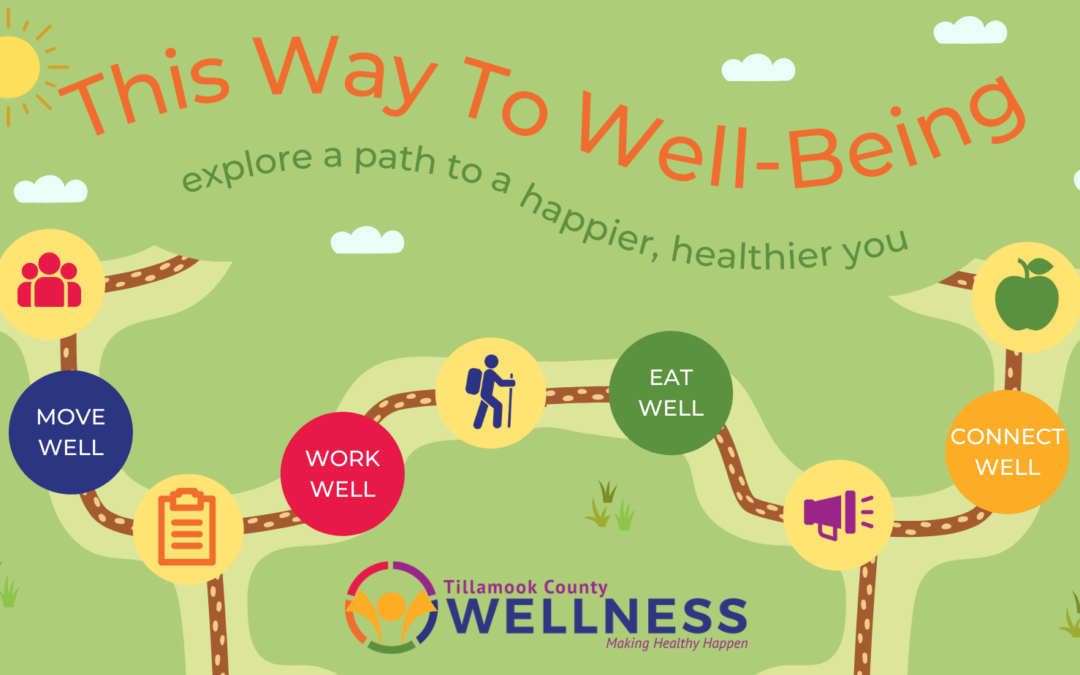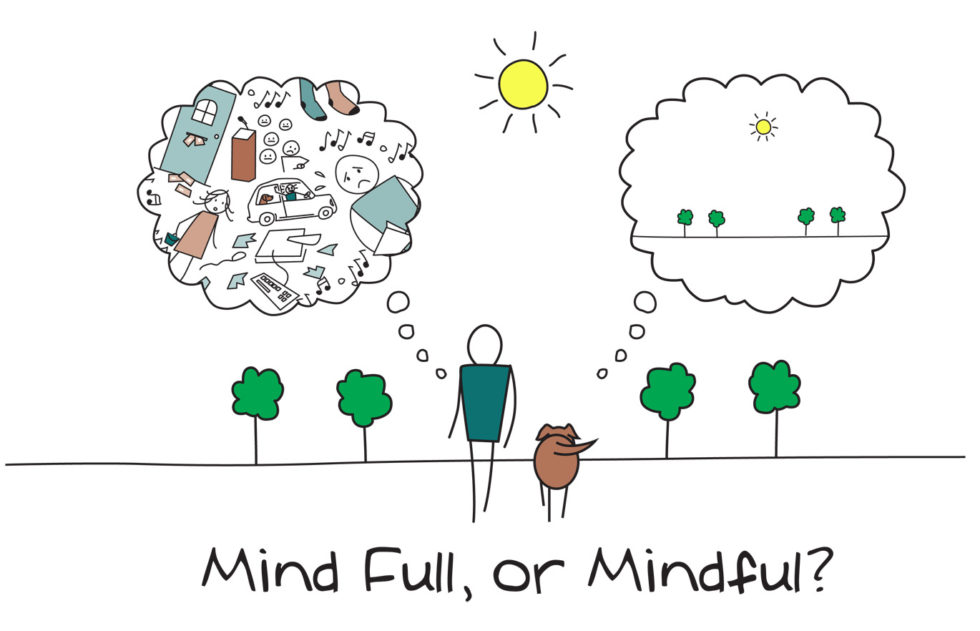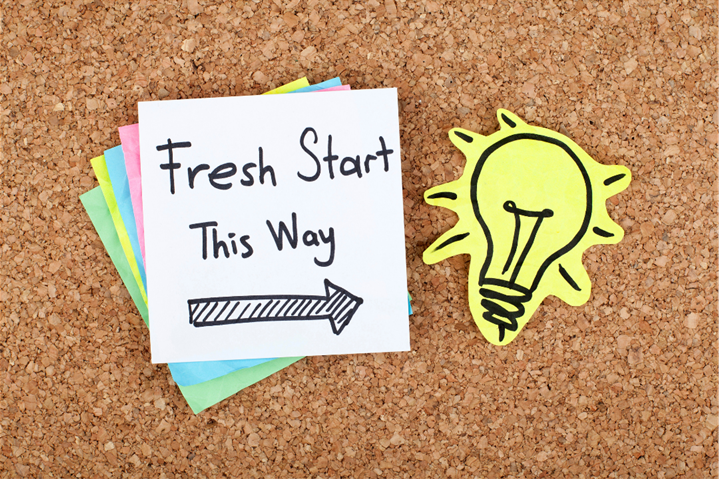
by Guest | Mar 30, 2022 | Being Well
Health is most often measured in numbers – our blood pressure, blood sugar (or A1c), cholesterol, weight, waist circumference, and so on. While these are important measures and they do tell us a lot about our risk for diseases (which we now know to be preventable by as much as 80%!), moving these numbers is harder than we ever imaged. The further away we get from our “ideal” numbers, the harder it is to achieve them.
This has caused a shift in how we approach health and well-being. While those numbers are important, they may be secondary to other key factors which we also know contribute to a person’s health; such as how we feel about ourselves, how equipped we are in life to pursue and attain our goals and how well we are able to maintain healthy relationships with others.
Interestingly, our biometric scores and our social and mental well-being are in fact interconnected. How we live our lives, what we eat, how we move our bodies, how much we sleep, the choices we make around our entertainment, our friend groups and use of tobacco, alcohol and other addictive substances, all determine those health numbers. Because each of those choices is serving a purpose in our lives, it can be very difficult to change those behaviors. Instead of “giving things up,” we may have more success adding something we value even more.
By focusing on positive, social actions we can take in our daily lives, we may actually have a better chance of moving our health numbers in the right direction. Exploring activities that bring us a sense of joy and fulfillment can be very motivating and contagious. It’s a great way to meet new people, build self-esteem and grow in our personal and professional lives. Our peer groups and associations influence our behaviors. When we join activities where people are modeling healthier behaviors, we are more likely to adopt them by default.
It is important to recognize that the path to wellness looks different for each person. We all have different interests that motivate us as well as different challenges or barriers that prevent us from sticking to healthy habits. By looking at the things we want to do, we stand a much better chance of getting on – and staying on – a path to well-being.
To help you navigate what that path might look like, we have developed a handy map of fun activities. We have many local options for investing in ourselves, connecting with others, exploring the outdoors, enjoying locally produced foods and more. You may even think of some things we haven’t included. The point is, there is no wrong path as long as it is leading toward a healthier, happier you.
As an added bonus, visiting points along the map gives you a chance to win prizes, such as movie tickets, hydro flasks, county and state parks passes, Tillamook County Fair tickets, gift cards to local businesses, and more. Winners will be selected at random from group events and activities April 6th through October 31st. This program is free and everyone is welcome to participate.
You are automatically eligible to win prizes for in-person activities such as walking groups and hikes, fitness classes, visiting Food Roots and attending local workshops. Sometimes we just can’t make classes or other activities fit into our busy schedules. Don’t worry – we have you covered too. Share a photo or post about what you’ve discovered along your wellness journey and tag us @TillamookCountyWellness on Facebook or Instagram to be entered to win. (You can also enter to win through a quick participation survey on our website here).
Are you ready to start exploring?
- Grab your free Way to Well-Being map at participating locations*, your local Tillamook County library branch or download it online (*Participating locations include: North County Recreation District (NCRD), Tillamook County Family YMCA, Kiawanda Community Center, and Food Roots.)
- Decide which activities you will explore and mark them on your calendar
- Invite friends and family to join you
- Share your discoveries at the Tillamook County Wellness Facebook & Instagram pages
- Explore your way to wellness from April through October 2022 to be eligible to win prizes
- Questions? Contact us at info@tillamookcountywellness.org
Annual Walking Group Launch April 6th
Let’s get things kicked off with our annual Walking Group launch on April 6th! Explore local walking routes and trails while meeting new people. Groups meet weekly, rain or shine. Drop-ins are welcome. Check out the full schedule here. Can’t find a group that works for your schedule? Feel free to start your own!
AUTHOR: Michelle Jenck, Director of Community Well-Being at Adventist Tillamook
Other wellness questions? Email us at info@tillamookcountywellness.org. For more local health and wellness information, visit www.tillamookcountywellness.org or follow Tillamook County Wellness on Facebook and Instagram.

by Guest | Mar 22, 2022 | Being Well
What is your role at the Tillamook Family Counseling Center and what drew you to this work?
My role at Tillamook Family Counseling Center is a Behavioral Health Clinician. I am a licensed clinical social worker, certified gambling addiction counselor and certified alcohol and drug counselor. My role as the certified gambling addiction counselor includes treatment for the people with problem gambling and their concerned others, education to our staff, community partners, and our community members, and outreach to our community to increase the awareness that services are available for people struggling with problem gambling.
What is your favorite part of your role? What is most challenging?
My favorite part of my role is being able to see the moment when a client is ready for change, and they begin to establish their recovery.
I would say the most challenging part is when a client is not ready for change, having them remain engaged in services to explore that ambivalence in treatment. Many times, people think if they are going to attend treatment they will immediately have to stop gambling and that’s not always true. It depends on the person. We can use harm reduction techniques to assist them with slowing down the gambling and deciding what’s best for them for their treatment and recovery. I’ve worked with people who need to abstain from gambling, and I’ve worked with people who were able to successfully utilize money and time barriers, monthly financial snapshots, and other helpful tools learned in treatment where they are able to continue to gamble responsibly.
What exactly is problem gambling?
It might be best to start with what is gambling? “Gambling can be defined as placing something of value at risk in the hopes of gaining something of greater value” (Potenza 2006). When I was going through my training, I learned that there were forms of gambling that I didn’t even realize were gambling, such as bingo, raffles, and gambling that can happen within the stock market. There is also gambling happening within video games.
The definition of problem gambling that I would like to share is from the National Council on Problem Gambling Website (https://www.ncpgambling.org). “Problem gambling–or gambling addiction–includes all gambling behavior patterns that compromise, disrupt or damage personal, family or vocational pursuits. The symptoms include increasing preoccupation with gambling, a need to bet more money more frequently, restlessness or irritability when attempting to stop, “chasing” losses, and loss of control manifested by continuation of the gambling behavior in spite of mounting, serious, negative consequences. In extreme cases, problem gambling can result in financial ruin, legal problems, loss of career and family, or even suicide”.
How does problem gambling impact an individual and the people around them?
People are not only gambling with money. When we look deeper, they are gambling with their relationships, safety/security, job, housing, time, integrity, and ultimately their life. Gambling disorder is associated with poor general health. There are high comorbidity rates with gambling and substance abuse, as well as mental health. Sometimes treatment will need to incorporate all three areas (gambling, substance use, and mental health). Concerned others are able to enter treatment to learn healthy boundaries, assertive communication, and more about what gambling addiction is. They are able to learn ways to not continue to contribute to the other person’s problem gambling.
Are there any misconceptions about problem gambling? What do you wish people knew?
Problem gambling is an addiction. You can experience withdrawal symptoms from gambling. It impacts some of the same areas of the brain as seen with substance use. Problem gambling treatment includes areas of focus such as financial barriers, creating a monthly financial snapshot, and wellness planning to address and expand upon the 8 dimensions of wellness. I highly encourage family therapy and participation in Gambler’s Anonymous.
How can community members find support or services for problem gambling?
If someone would like to access treatment, they can call TFCC at 503-842-8201 and request to schedule an appointment. They are also able to access services by calling 1-877-My-Limit (1-877-695-4648). It’s important to remember that problem gambling treatment services are free for the person struggling with problem gambling as well as concerned others that are impacted by that person’s problem gambling. The treatment services are paid for by the Oregon Lottery. We also have a local Gambler’s Anonymous meeting that is held Tuesdays at 5:30pm at the Serenity Club. At times the GA meeting can be virtual so please call the Serenity Club to confirm if it is in-person or to obtain the virtual meeting link.
Is there anything else you would like to add?
There is a 70% success rate with treatment if the client is able to utilize financial barriers and tools, have engagement with family therapy, and attend self-help meetings such as Gambler’s Anonymous.
Other wellness questions? Email us at info@tillamookcountywellness.org. For more local health and wellness information, visit www.tillamookcountywellness.org or follow Tillamook County Wellness on Facebook and Instagram.

by Guest | Mar 2, 2022 | Being Well
March is nationally recognized as Problem Gambling Awareness Month (PGAM). This year’s theme is “Awareness + Action”. The goals for this public health observance are to raise awareness of problem gambling, increase problem gambling screenings, and to increase the awareness of problem gambling prevention, treatment and recovery services. To learn more about this national observance visit the National Council on Problem Gambling’s website at www.ncpgambling.org.
What is problem gambling?
Problem gambling is when a person experiences negative life consequences that are directly related to their gambling.
Who can be impacted by problem gambling?
People of all ages can develop problems with gambling. According to the Oregon Health Authority, it is estimated that 180,000 Oregonians are at risk of developing a problem with gambling, and an estimated 84,000 Oregon adults and adolescents who meet the clinical diagnosis of a gambling disorder.
Can you tell me more about problem gambling among the youth population? If they are not at a legal age to gamble, how are they gambling?
According to the Oregon Health Authority, there are an estimated 6,000 Oregon youth (12-17 year olds) who are at risk of developing or have already developed a problem with gambling. Common ways that youth gamble include: cards, sports, fantasy sports, games of skill, dares, video games, and lottery products. According to the Oregon Health Authority, 11th grade students who gamble have an increased risk of truancy at school, sadness, substance use, and physical violence.
What are the public health impacts of problem gambling?
Common public health impacts include: mental health, physical health, relationships, co-occurring substance use, and increased suicide ideation. To learn more about these public health impacts, check out the Oregon Health Authority’s Impacts of Gambling on Public health. This document can be found at www.oregon.gov.
Are there steps that I can take to prevent problem gambling?
Yes, problem gambling can be prevented. A person can avoid this concern by utilizing prevention strategies, such as learning the warning signs, creating responsible gambling guidelines, and having conversations about gambling.
What are warning signs? Can you give me some examples of common warning signs?
Problem gambling warning signs are physical, verbal, or behavioral signs that can help a person determine if someone they know may have a problem with gambling. Common warning signs include: gambling to escape problems, isolating oneself from family or friends, using funds that were meant for other purposes to gamble, absences from school or work, and decreased interest in other activities.
What are responsible gambling guidelines? Could you give me examples of responsible guidelines?
Responsible gambling guidelines are rules a person can follow to help them gamble in a responsible way. Responsible gambling guidelines can include: setting a time limit, setting a dollar limit, creating a healthy life balance, and choosing not to gamble while using substances like alcohol.
I don’t hear much about problem gambling in day-to-day conversations. Is this a conversation that I should start having?
Yes, it would be beneficial to start having conversations about gambling with family, colleagues, and friends. These types of conversations can help to raise awareness of this public health concern, provide others with information about the negative impacts of problem gambling, share helpful prevention strategies, and share information about local problem gambling treatment services. For helpful conversation tips visit www.opgr.org.
Are there problem gambling services available locally?
Yes, there are problem gambling services available locally. The Tillamook Family Counseling Center is Tillamook County’s problem gambling prevention and treatment location. If you are interested in learning more about local prevention services please reach out to me at Janeanek@tfcc.org. If you are interested in free and confidential problem gambling treatment call (503)842-8201. Additional problem gambling resources are available from the Oregon Problem Gambling Resource (OPGR). For more information about OPGR visit www.opgr.org or call (877)695-4648.
AUTHOR: Janeane Krongos, Prevention Specialist at the Tillamook Family Counseling Center
Other wellness questions? Email us at info@tillamookcountywellness.org. For more local health and wellness information, visit www.tillamookcountywellness.org or follow Tillamook County Wellness on Facebook and Instagram.

by Guest | Feb 2, 2022 | Being Well
Social media is a mixed bag of sorts. It can lead to poor sleep quality, and fuel mental and emotional fatigue. It can be a very toxic experience depending on your perspective, how much time you spend on it, who you follow, and how you choose to interact. It can also be a wonderful tool which connects you to the people you love, niche hobby groups, meet-up opportunities, cultural awareness, and so much more! It’s a truly powerful source of communication. The speed in which the information, thoughts, feelings, and concepts within the content is exchanged can quickly overwhelm and exhaust anyone. It’s healthy to sometimes step back and take a break from the virtual world for a period. There are other ways to engage online which might help lessen the stress you’re feeling from the content you consume.
Being intentional about who you follow can make or break your experience online. There is so much aggression and misinformation, curating your feed will change the way you see the world. Follow users who matter to you and unsubscribe from those who cause you undue stress. Some differences in opinion are totally healthy and normal, but if those you follow engage in a way that is disrespectful, what are you gaining from that connection?
Find stimulating content creators that reflect your unique interests. This can help you to meet others virtually and build a real connection over time! You might find a local group meet-up to make friends in person. Social media is intended to foster connection and collaboration, it’s all about how you use it.
On the other hand, seek out accounts from people with diverse interests and perspectives. Find people from cultures completely different than your own. Find people who don’t look or think anything like you and try to put yourself in their shoes. Social media functions by putting us in a labeled box and providing increasingly tailored information to us based on our activity. Building cultural awareness is an intentional process but can lead to unbelievable opportunities and insights.
Sometimes it can seem like there are insurmountable divides in our society, and closing those gaps starts when we see the world through someone else’s eyes. Social media allows us to conveniently see and interact with perspectives from all over the world for the first time in human history. It gets a bad rep, but as with any technology it’s all about how it’s used.
Phones nowadays have locks and filters that can limit the amount of time we spend on social media apps. They have analytic trackers that can show you your usage history. These are valuable tools at your disposal! The distraction of a never-ending news feed can be alluring, but the apps benefit when you lose track of time. Setting timers on your phone will put the power back into your hands. Taking a break from social media all together is a wonderful chance to recalibrate and connect back in with yourself.
Social media should be used to your advantage, not to take advantage of you. Hopefully these tips can help you to feel more in control over your feeds and encourage you to try something new!
AUTHOR: Erin Washbon, OHSU Dietetic Intern
Other wellness questions? Email us at info@tillamookcountywellness.org. For more local health and wellness information, visit www.tillamookcountywellness.org or follow Tillamook County Wellness on Facebook and Instagram.

by Guest | Jan 19, 2022 | Being Well
Hoping to slow down and embrace living in the moment this year? After another unsettling year, many of us are looking to regroup and find a “new normal” as we enter into the new year. Dedicating a few minutes a day to mindfulness can help reduce stress, increase calmness and clarity, and promote happiness – and who couldn’t use a little more of that in 2022?
Too often, we find ourselves in a frenzied, unhappy and unsettled state-of-mind. Many people simply feel there are not enough hours in a day. Cultural norms tell us that multitasking is good, that “busy-ness” is both normal and noble. People are told to learn to say “no” but find it difficult because everything seems to be of equal and vital importance.
This constant state of activity and worry places a heavy toll on both the mind and the body. It can contribute to anxiety, depression, addiction and damaged relationships. An overloaded nervous system, in a constant state of fight-or-flight, produces chronic stress that has far-reaching effects.
Enter Mindful-Based Stress Reduction. Through a regular practice of cultivating awareness of experiences and sensations and learning to view them without judgement, things begin to fall into place. Priorities shift and emerge. Our sensory system remains calm amidst a stressful day. We experience life with a sense of clarity and objectivity.
We can only change something if we know what the root of the problem is. A mindfulness practice strips away every voice – including our own. We become an interested observer of what is happening in the body and the mind. It is like watching a movie with flashbacks and foreshadowing. We are “let in” on the back story that explains the characters’ behavior.
The practice itself can be as simple as spending five minutes each day, sitting quietly, breathing deeply and simply being present with acceptance. We accept who we are, where we are, just as we are in that exact moment. Thoughts may come and go and that’s okay. Often, they provide clues as to the source of our anxiety, past hurts, and frustrations. Rather than stuff them or block them, we allow these thoughts and feelings to appear. We greet them at the door but we don’t invite them to stay.
While a regular, defined practice is ideal, we can incorporate mindfulness into everyday activities. We can catch ourselves reacting to a situation and tune into it through our mindfulness viewer. Research shows that awareness in and of itself is enough to alter patterns of behavior. It takes on a snowball effect. The more we catch ourselves, the more quickly we hit the reset button until the brain recognizes the situation as non-threatening and resets itself. It is important to remember that, when we catch ourselves in an unhealthy habit, we do not attach any negative self-criticism. Acceptance without judgement is key. Setting an intention for healthier behaviors and self-healing are equally important.
As with any new task, the more often we practice the new habit, the more automatic it becomes. And just like building our muscles or mental focus, regular practice creates a new default. Two important benefits of a mindfulness practice are nonreactivity and self-regulation. Without expressly working to develop them, these two traits emerge. We often only realize it when we catch ourselves remaining calm in a situation that would have generated fear or anger before.
Mind-body classes such as Qigong, Tai Chi and Yoga include a component of mindfulness. Locally, class schedules can be found at the Tillamook Family YMCA or in the Tillamook Bay Community College course catalog under the community education, Fitness & Health section.
To learn more, check out the New York Times “How to Meditate” for mindfulness and meditation basics, at-home exercises, and strategies for any challenges you may face. If you are looking for guided mindfulness videos, there are many worth exploring online. Try checking out the “Goodful” page on YouTube for meditations, or look for the “Calm” or “Headspace” pages on YouTube, the app store, and streaming platforms (you can find “Headspace Unwind Your Mind” on Netflix or “A World of Calm” on HBO Max).
AUTHOR: Tillamook County Wellness
For more local health and wellness information, follow Tillamook County Wellness on Facebook, Instagram and Twitter.

by Guest | Jan 12, 2022 | Being Well
Every day we hear the results of another study, telling us what is making us unhealthy. Eat this, don’t eat that. Move like this, not like that. It can be overwhelming to figure out what to prioritize or even where to begin.
Awareness. This is where it all starts. We see things more clearly when we take a step back and give them our undivided attention. Take a few moments each day to breathe. Just be. Relax. In doing so, the busyness of the world, the noise of our self-talk, the daily to do list, they all disappear and we are simply left with ourselves and the truth. Layers of thought, emotion, and even traumatic events are often responsible for the “dis-ease” that causes disease. Without going through this process, it may not matter what changes we make to our nutrition or exercise habits. Our bodies seek balance. This applies to our emotional state as well. When we are out of balance, there are a whole host of physiological processes that go off-line as well.
Unfortunately, the typical American lifestyle does not lend itself to mind-body balance. Change is hard. Crazy hard. It’s really inconvenient. It is human nature to take the path of least resistance. It takes time and effort to change the way we live our lives. For most of us, this is where we end up – in a state of knowing we need to do something but not believing that we can really do anything about it. To be successful, we need to make the changes to our habits small, easy-to-adopt, and enjoyable.
Tips for Successful Behavior Change
Why we want to make changes is almost as important as what we want to change. The “why” often determines our chances for success. If we are making a change for our spouse or boss, or as a quick fix (think high school reunion), we might not be as emotionally invested as we need to be successful over the long term. You need to have good reasons to make any lasting change. Maybe it is to be around to see your kids or grandkids grow up or maybe it is about improving your quality of life. Whatever it is, it needs to be meaningful to you.
Setting SMART goals is key to successful behavior change. SMART is an acronym for research-based characteristics that significantly increase the likelihood of reaching one’s goals. They should be:
- Specific
- Measurable
- Attainable
- Relevant
- Time-Bound
For example, if I want to walk 2 miles a day but am currently completely sedentary, I need to break down my goal into manageable pieces. I also need to be realistic. How far can I, and more importantly, will I, walk each day. Maybe it is just a daily walk to my mailbox for the first week. Then, I can walk to the end of the block, then 3 blocks, and so on until I have achieved my goal. It is important to set a time frame for each level of goal attainment. This can be daily or weekly. It needs to be short enough to generate immediate success but also long enough to form a new habit as a foundation for the next step and that usually takes about 8-10 weeks.
Work with your strengths and interests when approaching changes. If you like to cook, then it makes sense to find healthy recipes you would enjoy making. If you hate cooking, it will be important to simplify what nutrition changes you are making so that you can still be successful. It can be as simple as choosing the prepared veggie tray and a container of hummus from the grocery store. This principle is especially important when it comes to physical activity. If you enjoy being outdoors, consider walking or hiking. If you like people, music or dancing, you could join a group fitness class. If you want something more mindful, try Tai Chi, Qigong or Yoga. The key is to look for ways to integrate a positive, healthy change with your personality, interests and strengths.
One of the reasons people struggle with behavior change is because they have been unsuccessful in the past. Three common reasons for this are 1) Setting unrealistic goals 2) Giving up after the first setback, or 3) Taking on too many changes at once.
To avoid these, it is important to set a narrow list of ridiculously small goals. This allows us to celebrate mini victories which perpetuate future successes. BJ Fogg, a researcher at Stanford University, recommends starting with what he calls “Tiny Habits.” He uses an example for someone who wants to develop the habit of flossing their teeth. He suggests flossing one tooth each night after brushing your teeth. Just one tooth. A small, simple act is perceived as more doable and we may be more likely to persist and build on that activity. This is a very real characteristic of human nature and it explains a lot when it comes to why behavior change is so difficult.
To summarize, there are some tricks to successful behavior change:
- Become aware of what you want to change and why
- Set SMART goals
- Make changes that fit your personality, strengths and values
- Start small (REALLY small) and build on your successes
AUTHOR: Michelle Jenck, M.Ed., Community Well-Being Director, Adventist Health Tillamook
For more local health and wellness information, follow Tillamook County Wellness on Facebook, Instagram and Twitter.






